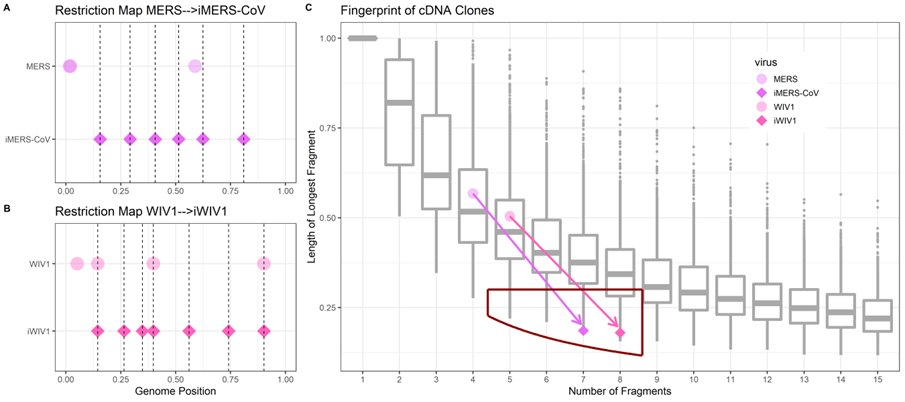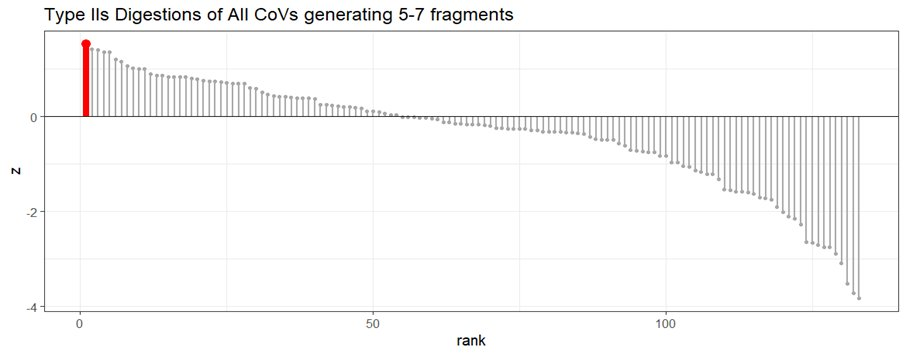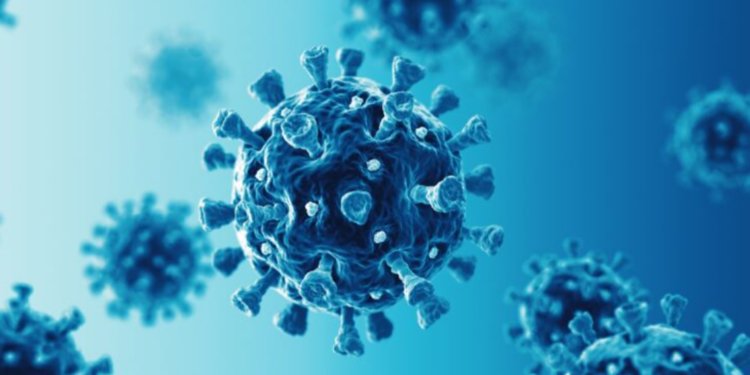The COVID-19 coronavirus SARS-CoV-2 has a telltale “fingerprint” that means it is highly likely to have been made in a lab, new research has found.
Mathematical biologist Dr. Alex Washburne and colleagues Valentin Brutte and Antonius VanDongen have published their research in a preprint that found “a high likelihood that SARS-CoV-2 may have originated as an infectious clone assembled in vitro”.
They explain that this evidence, which they term an “endonuclease fingerprint”, is independent of the evidence relating to the Furin Cleavage Site, which others have suggested is a ‘smoking gun’ for a lab origin.
Dr. Washburne stresses that he is not alleging malign intent or even gain-of-function work in this paper. He writes: “We find no evidence of SARS-CoV-2 being a bioweapon (on the contrary, this looks like an accident) or any gain of function work. We find evidence suggesting SARS-CoV-2 may have been synthesised in the lab with known methods, probably for normal pre-Covid research purposes.”
Professor Francois Balloux has given the study his imprimatur on Twitter, writing: “This is an important piece of work. To me, it looks solid both conceptually and methodologically. I was given advance warning and was able to replicate the key findings. To the best of my knowledge, I confirm the reported patterns are genuine.”
To accompany the study Dr. Washburne has published a Substack and a Twitter thread. The Twitter thread is reproduced in full below – it can be a bit technical in places, but the message it’s conveying should come through clearly enough.
The origin of SARS-CoV-2 is unknown. Some hypothesised two spillover events at the wet market, but methodological flaws make that work inconclusive. We need to know the true origin of SARS-CoV-2 to prevent pandemics.
We examined whether SARS-CoV-2 was synthesised in a lab. We studied a common method for synthesising coronaviruses (CoVs) in the lab. This method was thought to not leave a fingerprint. We found the fingerprint. That fingerprint is in the SARS-CoV-2 genome.
Here’s how you make a CoV in the lab. To make a 30,000 base (30kb) RNA virus in the lab, you need a 30kb DNA clone. To assemble a 30kb DNA clone, scientists glue together several smaller fragments.
A popular method for DNA assembly is ‘golden gate assembly’.

Golden gate assembly requires the DNA sequence have special ‘cutting’ sites (type IIS restriction sites). Cutting sites create three to four nucleotide (nt) ‘sticky ends’. Sticky ends help you ‘paste’ DNA segments together, ensuring faithful assembly of your 30kb DNA copy of a viral genome.
RNA viruses like CoVs are not under selection specifically for this kind of cutting and pasting. So, wild viruses tend to have cutting and pasting sites randomly scattered in their genome. Researchers building viruses in a lab will often add or remove cutting sites.
We collected examples of CoV infectious clones assembled with these type IIS cutting and pasting systems from 2000-2019. We found a clear pattern in how researchers tended to add or remove cutting and pasting sites.
Researchers tend to turn randomly-spaced restriction maps into regularly-spaced ones (A-B). Regular spacing comes from desiring fewer fragments (typically five to eight) while keeping the longest fragment lengths low.

Digesting 70 CoVs with 200-plus restriction enzymes yields a ‘wild type distribution’, a null model for how long the longest fragment may be as a function of the number of fragments [when the virus is wild]. The red box is the ideal range for reverse genetic systems used to make infectious clones.

CoVs engineered to be infectious clones will move from having restriction maps falling within the wild type distribution to being outliers under the wild-type distribution, falling within the lab-ideal range of fragment number and low longest-fragment-length.

Having found this fingerprint, we examine specific cutting and pasting sites in the SARS-CoV-2 genome (BsaI/BsmBI).
BsaI and BsmBI are very popular enzymes for this kind of in vitro assembly They also have many conserved sites in CoVs. Very useful for making chimeras.
The SARS-CoV-2 BsaI/BsmBI restriction map falls neatly within the ideal range for a reverse genetic system. It is an anomaly (bottom 1%) amongst wild type CoVs. It is a midpoint amongst engineered CoVs.

Digesting CoVs with only type IIS enzymes that could be used for assembly, SARS-CoV-2 is an even greater outlier. It’s in the bottom 1% max-fragment-length for all restriction enzymes. It’s the single largest outlier (<0.07%) of 1,491 type IIS digestions.

We then tested the lab-assembly hypothesis. If SARS2 has a synthetic origin via golden gate assembly, several other criteria must be met. For example: all sticky ends must be unique, non-palindromic and contain at least one A/T. SARS2 passed this test (60% chance of this).
The mutations separating SARS-CoV-2 BsaI/BsmBI sites from its close relatives must all be silent mutations. All 14 mutations in BsaI/BsmBI sites are silent. 84% of mutations in SARS2 and close relatives are silent, so 9% chance all 14 distinct mutations will be silent.
There’s a significantly higher concentration of silent mutations per nucleotide within BsaI/BsmBI recognition sequences than in the rest of the genome. P=0.004 for BANAL52-SARS2 P=9e-8 for RaTG13-SARS2.
Such an idealised reverse genetic system is unlikely to evolve by chance from the close relatives of SARS-CoV-2. There’s a 1% chance of random RaTG13 mutants having as great or greater z-score and 0.1% chance for BANAL52.

Testing this from multiple angles, we could not reject the hypothesis that SARS-CoV-2 has a synthetic origin. Each test also decreased the odds of SARS-CoV-2 having a natural origin. The BsaI/BsmBI fingerprint of SARS-CoV-2 indicates synthetic origin of SARS-CoV-2.
Please read our manuscript for our careful language and limitations. These are important. For example, our results are independent of the Furin Cleavage Site (FCS). While the RBD is docked in fragment 5, we shine no light on the origin of the FCS.
Our research does not identify the lab. We hypothesise this restriction map would enable construction of chimeric viruses, much like the recent controversial work done in Boston (but with a different method for in vitro assembly).
Our theory of a synthetic origin of SARS-CoV-2 can and should be tested. Further tests may reject our theory. We welcome these tests. Our code is available on GitHub and we point to future research that can reject our hypothesis or refine our understanding of this issue.
Making chimeric viruses in vitro carries risks. We encourage transparency from researchers studying CoVs in Wuhan. We strongly encourage global coordination on biosafety.
We encourage open, civil and compassionate discourse on this important topic. This pre-print was not rushed. It was reviewed by many colleagues, truly world experts. We thank them all immensely for their feedback. This has been an incredible project. Yet, for obvious reasons, this is the saddest paper I’ve ever written.
Stop Press: The paper has been heavily criticised by multiple specialists on Twitter, who have highlighted what they deem to be fatal flaws in it. Prof. Balloux has unexpectedly deleted his Twitter account, apparently in light of the criticisms of the paper, though he has not confirmed this. Dr. John Ross has (somewhat snidely) tweeted: “In case you missed it, U.K. Covid minimiser Francois Balloux has deleted his account after amplifying a spectacularly wrong preprint claiming to have proven that SARS-CoV-2 was synthetic (refuted below).”
Dr. Ross’s Twitter thread and the replies to it provide links to a number of criticisms of the paper.
Dr. Washburne has responded here and here defending his paper.
Matt Ridley has praised the response for being reasoned and without invective: “This thread is a good response to a reasonable criticism. Not an insult in sight. Science as it should be done.”














To join in with the discussion please make a donation to The Daily Sceptic.
Profanity and abuse will be removed and may lead to a permanent ban.